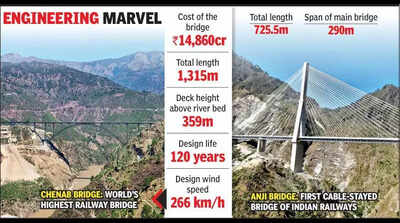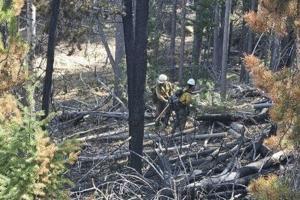In the heart of Jammu & Kashmir's rugged Reasi district, where the mighty Himalayas rise and the Chenab river carves its way through tectonically active terrain, two engineering marvels now stand tall—undaunted by nature's fury. In the past 48 hours, the region was lashed by heavy rains, thunderstorms, hailstorms, and gusty winds. But railway officials assure that none of it—nor anything even more severe—poses a threat to the soon-to-be-inaugurated Chenab and Anji Khad bridges, two symbols of India's engineering audacity.
Perched 359 metres above the Chenab river, the Chenab Bridge isn't just a railway structure—it's a statement. Taller than the Eiffel Tower and nearly twice the height of the Statue of Unity, it is the tallest railway arch bridge in the world. A marvel stitched together in steel and determination, it was designed not just to span a river, but to conquer earthquakes, winds, and the wildest moods of Himalayan weather.

"Both the Chenab bridge and the Anji Khad bridge can withstand wind speeds up to 266 km per hour. Even under extreme climatic conditions, their structural integrity remains unaffected," says Rajesh Khare, senior public relations officer (PRO) of the Northern Railway. The Anji Khad bridge, India's first cable-stayed railway bridge, stands nearby—sleek, poised, and equally formidable.
Together, they complete a missing link in India's railway dream: an all-weather, high-reliability transport corridor connecting the Kashmir Valley to the rest of the country. "The Chenab bridge lies near seismic zone 5, one of India's most earthquake-prone regions," adds Anubhav Saxena, PRO of Western Railway. "It is designed to withstand an earthquake measuring up to 7.
0 on the Richter scale. That's the level of resilience we've built into this structure." But these are not just feats of architecture.
They are chapters in the long-cherished story of connecting Kashmir to Kanyakumari. Until now, trains could only reach Katra. Beyond that, the serpentine Jammu-Srinagar National Highway was the only terrestrial lifeline into the Valley.
Now, that's about to change. Through a meticulous network of tunnels and bridges, including the Chenab and Anji Khad bridges, the Udhampur-Srinagar-Baramulla Rail Line (USBRL) is inching closer to completion. With it comes a revolution in connectivity, commerce, and cultural integration.
"Once trains start running on this route, it will not just be about convenience—it will be about transformation," Saxena emphasizes. "Goods will move faster, tourism will flourish, and communities long isolated by geography will finally feel part of the national mainstream." The trial runs of the Vande Bharat Express from Jammu to Srinagar's Nowgam station have already concluded in the picturesque Kashmir Valley.
All eyes are now set on the day when Prime Minister Narendra Modi will flag off the services..
















